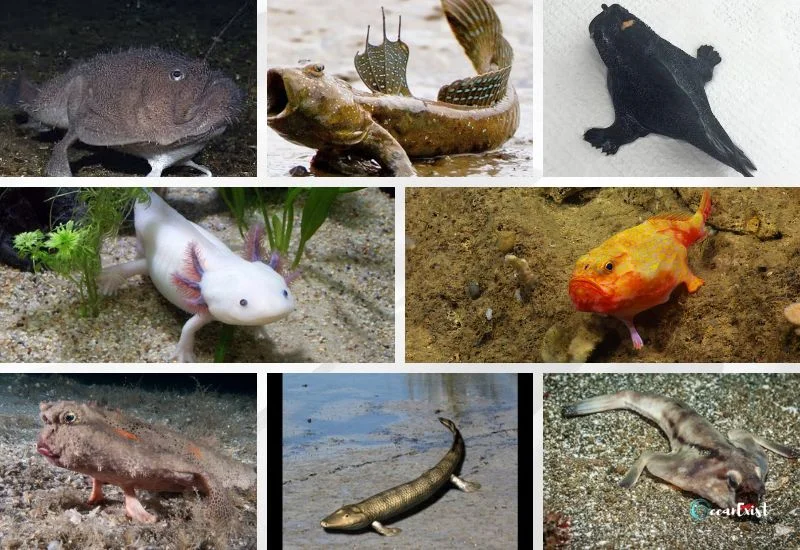Doesn’t it sound creepy that fish can walk, too? Yes, it is strange.
But, you should keep in mind that fish can walk too and have legs. Nature never ceases to amaze us.
Technically, many of the aquatic scientists call these legs limbs and negate that fish have legs. But their limbs or fins help them walk on the ocean floor or out of the water.
The distance they cover is short, but their locomotion is termed walking.
So, we have gathered the list of twenty-plus fish with legs with pictures that can walk and move around the floor with their so-called legs, i.e., limbs or fins.
Their amazing facts and hypnotizing secrets will make you their fan.
With facts and pictures, you will also come to know about facts and answers in bullet points.
- Scientific Name
- Diet
- Size
- Origin
- Legs
- Available to Hobbyists
- Tank Size
- Lifespan
So, why not move quickly to this blazing article? Let’s go!
Red-lipped Batfish
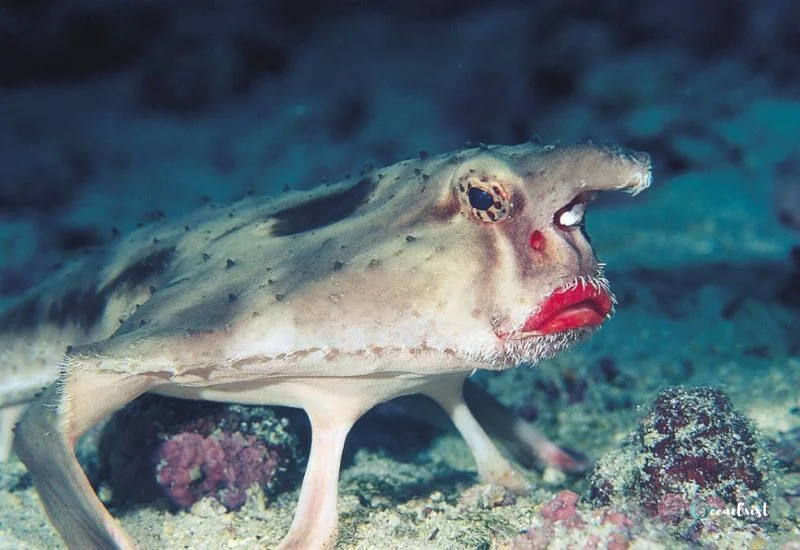
The Red-lipped Batfish (Ogcocephalus darwini) are easy to recognize. They have an odd look, with bright red lips like bold lipstick.
Found off the Galápagos Islands, red-lipped redfish use their fins to walk along the ocean floor.
- Scientific Name: Ogcocephalus darwini
- Diet: (Carnivorous) feeds on small fish and invertebrates
- Size: 8 inches (20 cm)
- Origin: Galápagos Islands in the Eastern Pacific Ocean
- Legs: Pectoral fins used for walking, no true legs
- Available to Hobbyists: Rarely available
- Tank Size: Minimum 30-gallon tank
- Lifespan: Around 5-10 years
Frogfish
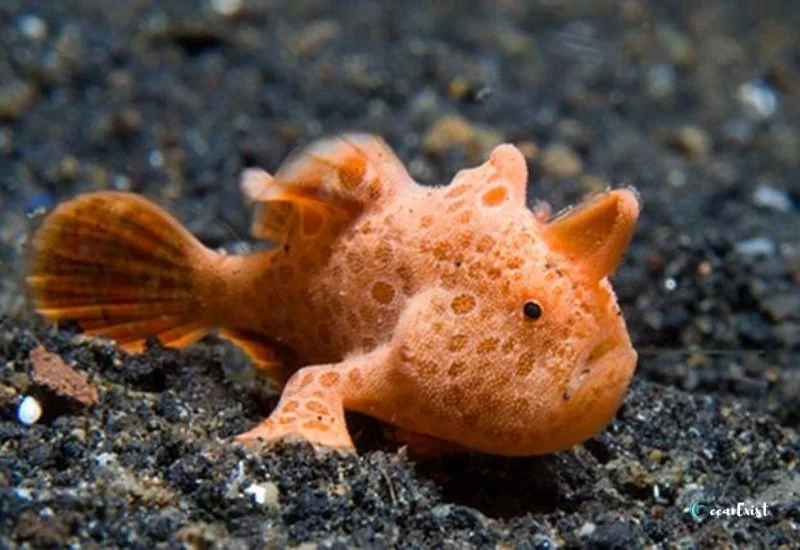
Despite their name, the Frogfish (Antennariidae) are a master of disguise. Resembling a colorful lump with fins, they can use their leg-like fins to slowly walk across the seafloor. It helps them wait to ambush unsuspecting prey.
- Scientific Name: Antennariidae
- Diet: (Carnivorous) ambushes prey using their expandable mouth
- Size: 1 to 12 inches (2.5 to 30 cm)
- Origin: Tropical and subtropical oceans worldwide
- Legs: fins used for walking on the seafloor
- Available to Hobbyists: Some species are available
- Tank Size: Minimum 20 gallons
- Lifespan: 3-15 years in
Mudskippers
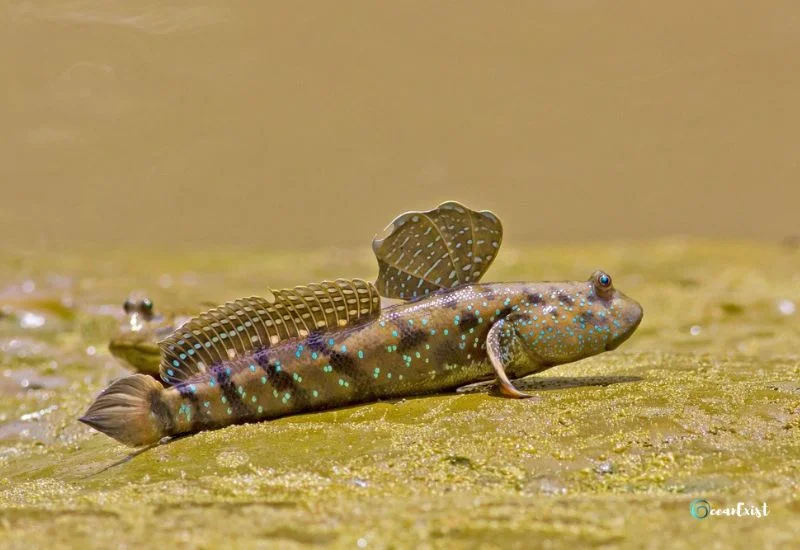
Mudskippers (Periophthalmus spp.) are iconic amphibious fish known for their ability to walk both land and water.
These small creatures can even climb trees using their pectoral fins.
- Scientific Name: Periophthalmus spp.
- Diet: (Omnivorous) feeds on insects, crustaceans, and algae
- Size: 2 to 12 inches (5 to 30 cm)
- Origin: Africa, Asia, and Australia
- Legs: pectoral fins as ‘legs’ for walking on land
- Available to Hobbyists: Popular in specialized aquarium setups
- Tank Size: 20-gallon tank
- Lifespan: 5-10 years in
Batfish
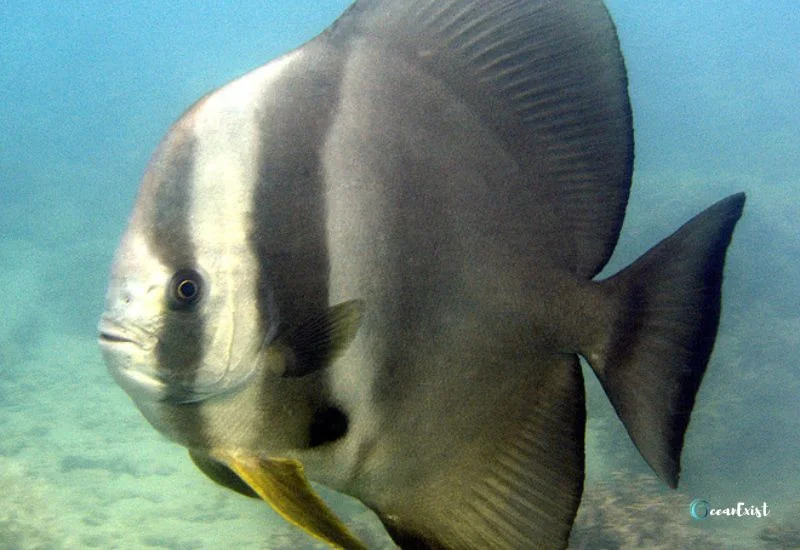
Batfish (Ogcocephalidae) are aptly named for their wing-like fins that resemble bat wings. They use these appendages to crawl across the ocean floor, displaying a unique form of movement.
- Scientific Name: Ogcocephalidae
- Diet: (Carnivorous) preys on small fish and crustaceans
- Size: 4 to 16 inches (10 to 40 cm)
- Origin: Tropical and subtropical waters
- Legs: pectoral fins resemble ‘legs’ for walking on the seafloor
- Available to Hobbyists: Some species are available
- Tank Size: Minimum 50-gallon tank
- Lifespan: Around 5-15 years in
Tiktaalik Roseae

An ancient fish with limb-like fins, Tiktaalik Roseae, represents a crucial transitional form between fish and tetrapods.
They lived around 375 million years ago and played a pivotal role in the evolution of land-dwelling vertebrates.
- Scientific Name: Tiktaalik roseae
- Diet: Likely (Carnivorous) fossils suggest a predatory diet
- Size: 4-9 feet (1.2-2.7 meters)
- Origin: Extinct species lived around 375 million years ago
- Legs: Transitional form with limb-like fins; not a modern fish
- Available to Hobbyists: Extinct; only known from fossils
Handfish
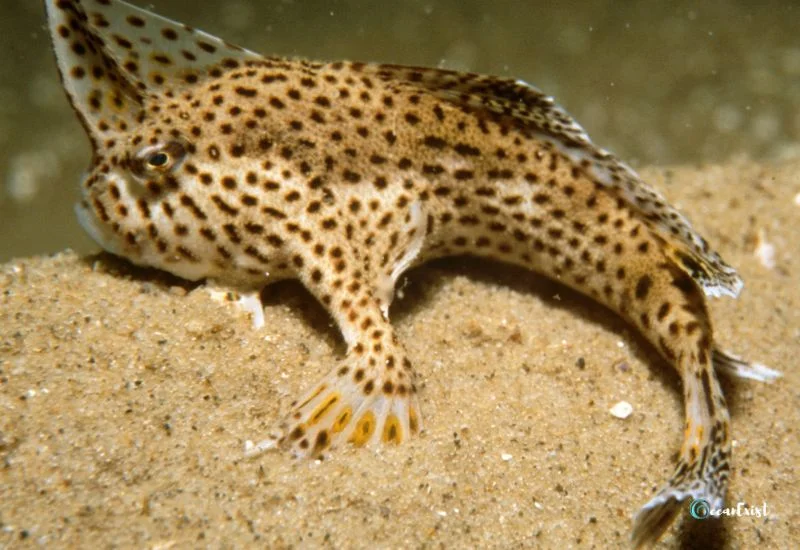
The Handfish (Brachionichthyidae) are a group of fish known for their distinctive hand-shaped fins that they used to walk along the ocean floor.
Sadly, many species of handfish are critically endangered due to habitat loss.
- Scientific Name: Brachionichthyidae
- Diet: (Carnivorous) feeds on small invertebrates and crustaceans
- Size: 2 to 6 inches (5 to 15 cm)
- Origin: Southern Australia and Tasmania
- Legs: Uses pectoral fins as ‘hands’ for walking on the seafloor
- Available to Hobbyists: Some species
- Tank Size: Requires a specialized setup
- Lifespan: 5 years in
Lungfish
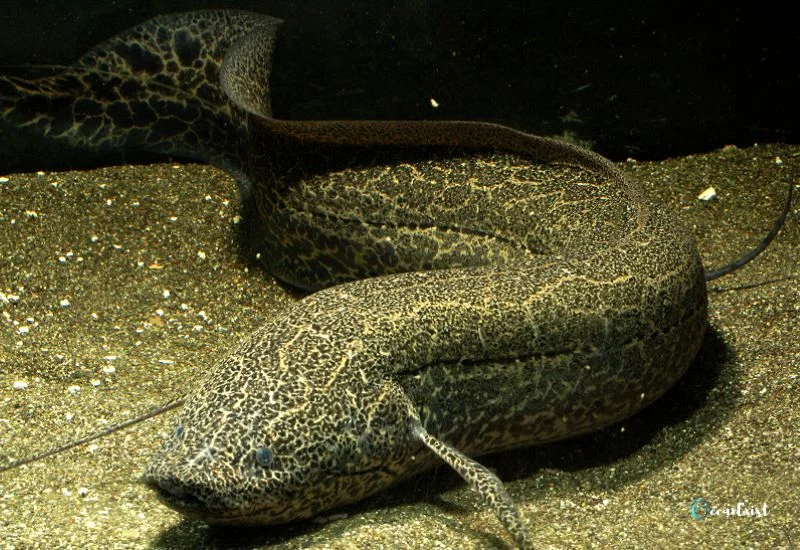
Lungfish (Dipnoi) are ancient fish known for their ability to breathe air.
Lungfish species can use their paired fins to walk short distances on land, making them fascinating examples of evolution.
- Scientific Name: Dipnoi
- Diet: (Omnivorous) feeds on small fish, insects, and plant matter
- Size: 3 feet (1 meter)
- Origin: Africa, South America, and Australia
- Legs: Paired fins used for limited movement on land during dry seasons
- Available to Hobbyists: Some species
- Tank Size: Requires a large tank or pond
- Lifespan: 10-20 years
Polypterus Bichir
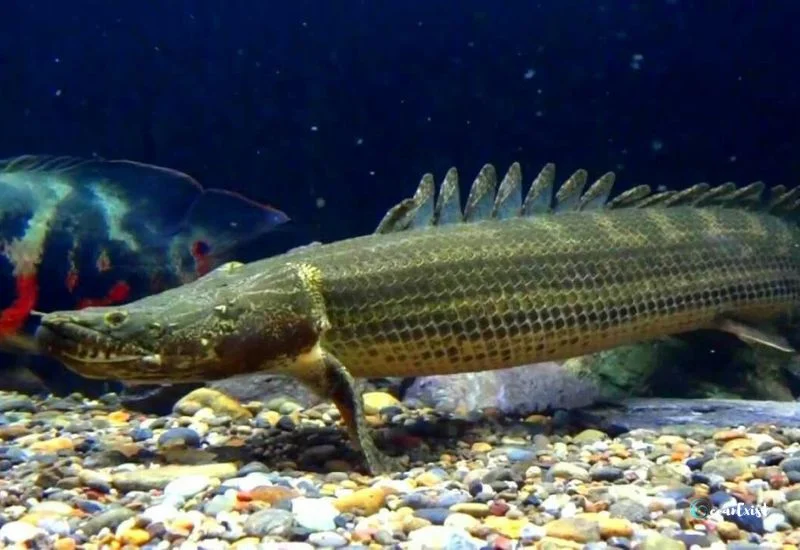
The Polypterus Bichir are a primitive fish native to Africa, characterized by their elongated body and multiple dorsal fins.
While primarily aquatic, these fish can move short distances on land using their paired fins.
- Scientific Name: Polypterus senegalus (Senegal Bichir)
- Diet: (Carnivorous) feeds on small fish, insects, and crustaceans
- Size:12-24 inches (30-60 cm)
- Origin: Africa
- Legs: Paired fins used for limited movement on land
- Available to Hobbyists: Commonly available
- Tank Size: Minimum 50-gallon tank
- Lifespan: 10-15 years
Axolotl

While not a fish, the Axolotl (Ambystoma mexicanum) are a unique amphibian closely related to salamanders.
Known for their regenerative abilities, the axolotls retain larval features throughout their life and are often referred to as the walking fish.
- Scientific Name: Ambystoma mexicanum
- Diet: (Carnivorous) primarily eats small fish, worms, and aquatic insects
- Size: 6-12 inches (15-30 cm)
- Origin: Mexico
- Legs: Four legs with webbed feet
- Available to Hobbyists: Very popular
- Tank Size: Minimum 20-gallon
- Lifespan: 10-15 years
Coelacanth
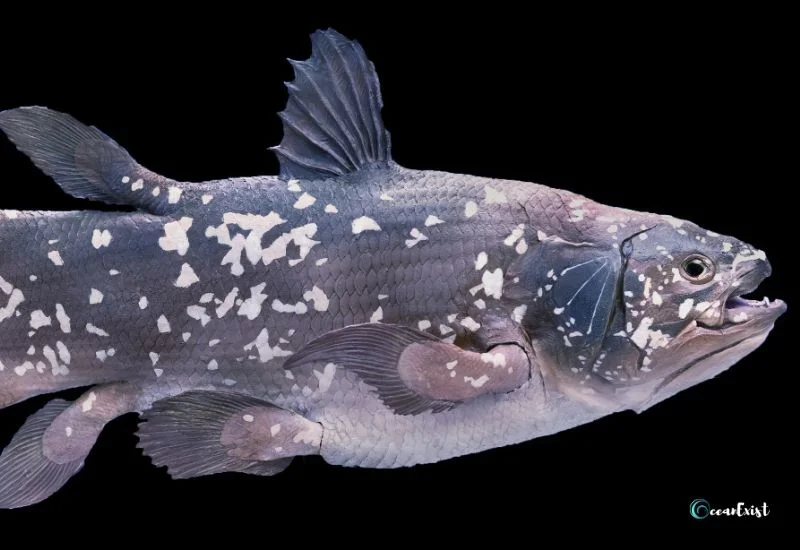
Coelacanths (Latimeria) are ancient fish that were thought to be extinct until a living specimen was discovered in 1938.
Although primarily marine, coelacanths possess limb-like fins that they can use for limited movement.
- Scientific Name: Latimeria chalumnae
- Diet: (Carnivorous) preys on fish and cephalopods
- Size: 5 feet (1.5 meters)
- Origin: Deep sea near the Comoros Islands and Indonesia
- Legs: Transitional form with limb-like fins; not capable of walking on land
- Available to Hobbyists: Not available
- Tank Size: Not suitable for aquariums
- Lifespan: Estimated to be several decades
Warty Frogfish
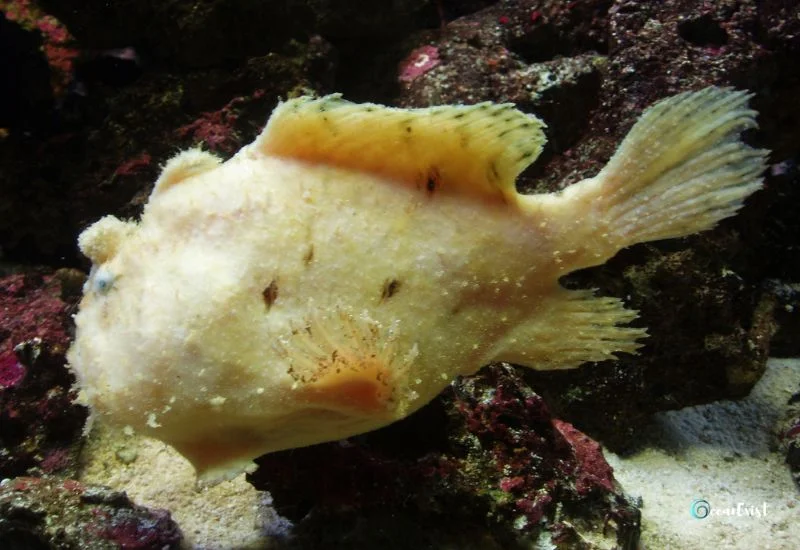
The Warty Frogfish (Antennarius maculatus) are a master of camouflage. they blend into their surroundings with their textured, wart-like skin.
These predators ambush prey using their fins to walk along the ocean floor. They surprise prey with lightning-fast strikes.
- Scientific Name: Antennarius maculatus
- Diet: (Carnivorous) ambushes prey using camouflage and rapid strikes
- Size: 2-4 inches (5-10 cm)
- Origin: Tropical and subtropical waters worldwide
- Legs: fins used for walking along the seafloor
- Available to Hobbyists: Some species are available
- Tank Size: Minimum 20-gallon tank
- Lifespan: 5 years
Snakehead Fish
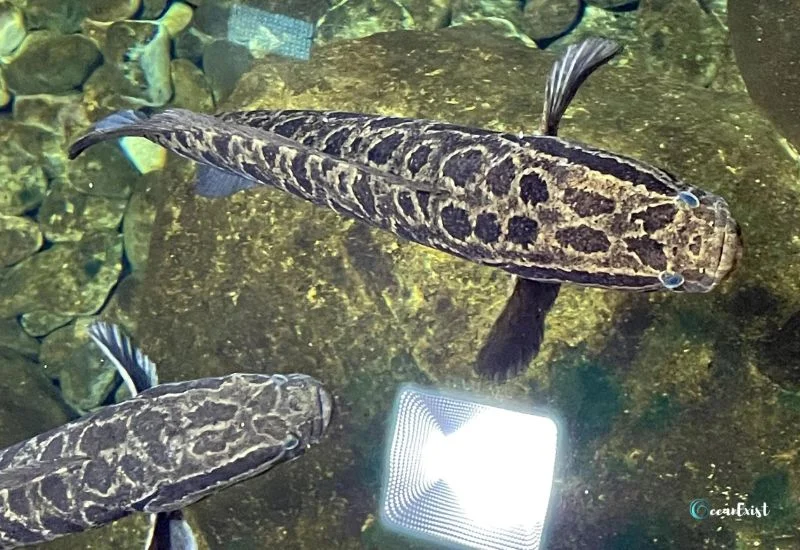
The Snakehead Fish (Channidae) are notorious for being a predator. They can survive out of water for a long time.
Snakehead species can use their pelvic fins to propel themselves short distances on land, aiding in their invasive spread in certain regions.
- Scientific Name: Channidae
- Diet: (Carnivorous) preys on fish, amphibians, and small mammals
- Size: 3 feet (1 meter)
- Origin: Africa and Asia
- Legs: short bursts of walking on land using their fins
- Available to Hobbyists: Some species
- Tank Size: Large tank or pond required
- Lifespan: 15 years
Epaulette Shark
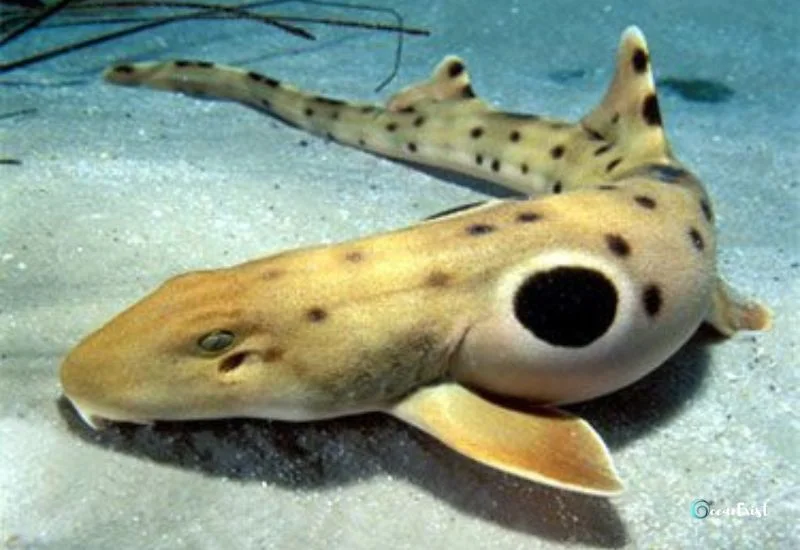
Epaulette Shark (Hemiscylliidae) are a small shark species found in the shallow waters of Australia and New Guinea.
Known for their unique walking behavior using their pectoral and pelvic fins, the Epaulette shark can navigate tide pools and coral reefs in search of prey.
- Scientific Name: Hemiscylliidae
- Diet: (Carnivorous) feeds on small fish, crustaceans, and mollusks
- Size: 2-4 feet (60-120 cm)
- Origin: Australia and New Guinea
- Legs: Uses their pectoral and pelvic fins to walk on the ocean floor
- Available to Hobbyists: Some species
- Tank Size: Requires a large tank
- Lifespan: 20 years
West African Lungfish
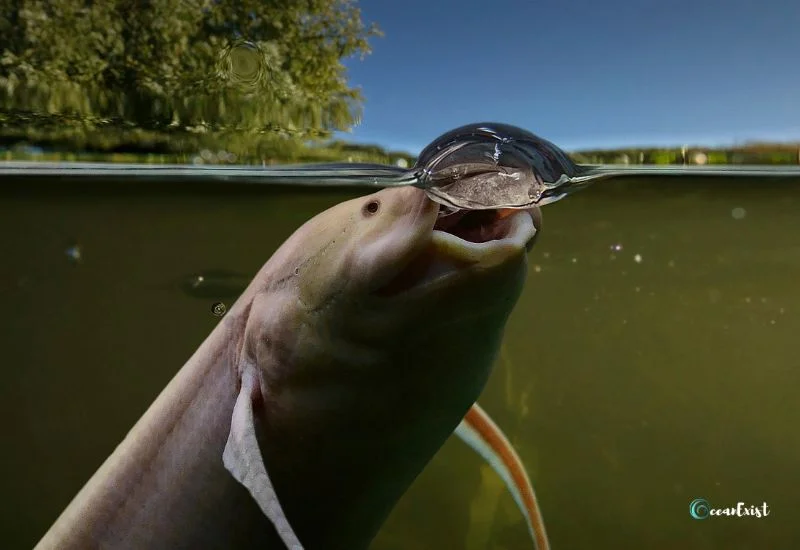
The West African Lungfish (Protopterus spp.) are a lungfish species native to the freshwater habitats of West Africa.
Like their relatives, they possess paired fins that allow them to walk on the bottom of water bodies during droughts or when seeking new habitats.
- Scientific Name: Protopterus spp.
- Diet: (Carnivorous) feeds on fish, insects, and small aquatic animals
- Size: 3 feet (1 meter)
- Origin: Found in freshwater habitats across West Africa
- Legs: Paired fins used for walking on land during dry seasons
- Available to Hobbyists: Somewhat rare
- Tank Size: Large tank or pond required
- Lifespan: 20 years
Sea Robin
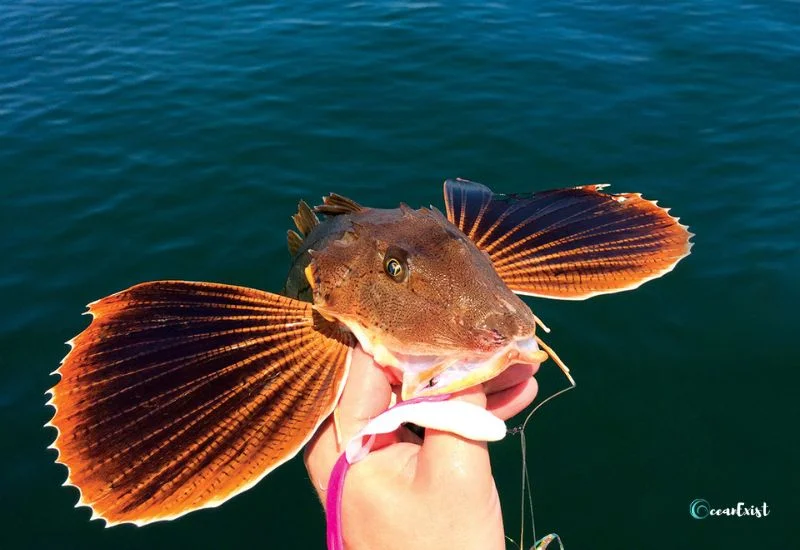
Sea Robin (Triglidae) are a bottom-dwelling fish characterized by their wing-like pectoral fins.
Even being mainly aquatic, Sea Robin uses their fins to walk along the ocean floor. There, they scavenge for small crustaceans and mollusks.
- Scientific Name: Triglidae
- Diet: (Carnivorous) preys on small fish, crustaceans, and mollusks
- Size: 6-18 inches (15-45 cm)
- Origin: Atlantic Ocean and Mediterranean Sea
- Legs: pectoral fins used to walk along the ocean floor
- Available to Hobbyists: Some species
- Tank Size: Requires a large tank
- Lifespan: 10 years
Walking Catfish
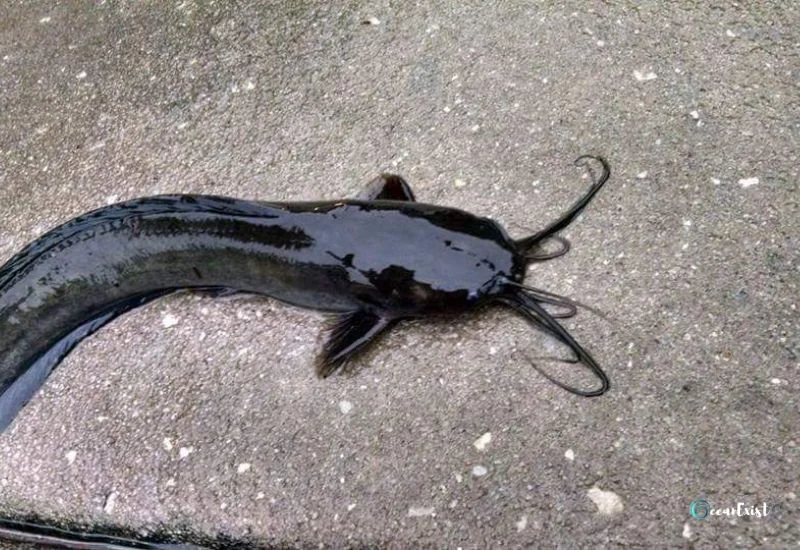
The Walking Catfish (Clariidae) are aptly named. They can move short distances over land using their strong pectoral fins and wriggling body.
They originated from Southeast Asia, and they are well-known for their adaptability and invasive tendencies.
- Scientific Name: Clariidae
- Diet: (Omnivorous) feeds on insects, worms, and plant matter
- Size: 2 feet (60 cm)
- Origin: Southeast Asia and Africa
- Legs: Uses strong pectoral fins and wriggling movements to walk on land
- Available to Hobbyists: Some species
- Tank Size: Large tank or pond required
- Lifespan: 15 years
Hillstream Loaches
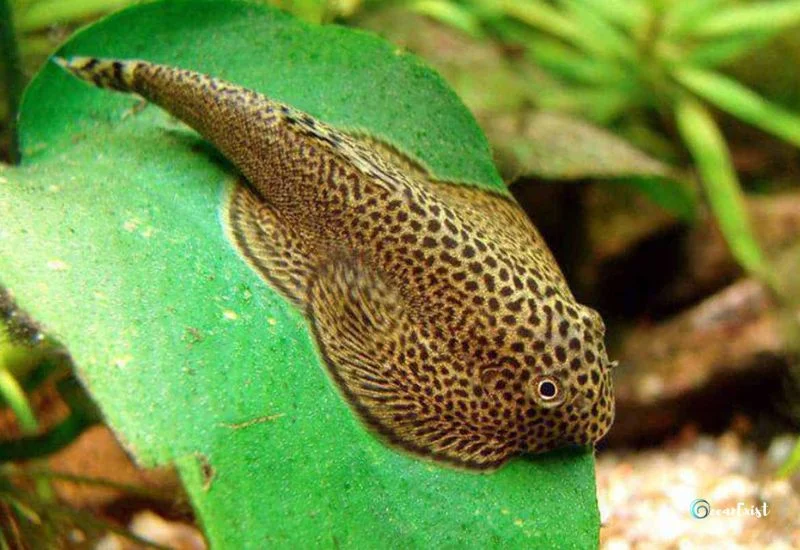
Hillstream Loaches (Balitoridae) are small, bottom-dwelling fish found in fast-flowing streams and rivers across Asia.
Having unique attributes, they have adapted to their environment by using their suction-like pelvic fins to cling to rocks. It helps them navigate swift currents.
- Scientific Name: Balitoridae
- Diet: (Omnivorous) feeds on algae, small invertebrates, and organic detritus
- Size: 2-6 inches (5-15 cm)
- Origin: Asia
- Legs: Suction-like pelvic fins
- Available to Hobbyists: Yes
- Tank Size: Minimum 20-gallon tank
- Lifespan: 10 years
Dinosaur Bichir
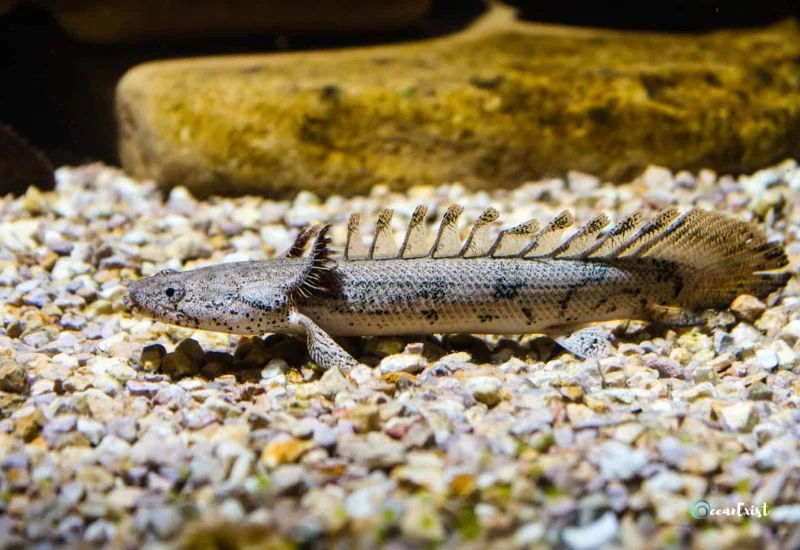
Dinosaur Bichir (Polypterus senegalus) are a prehistoric-looking fish with a primitive appearance. They had an elongated body and unique fin structure.
They can navigate shallow waters and occasionally walk on land using their pectoral fins.
- Scientific Name: Polypterus senegalus
- Diet: (Carnivorous) feeds on small fish, insects, and crustaceans
- Size: 12-24 inches (30-60 cm)
- Origin: Africa
- Legs: Paired fins used for limited movement on land
- Available to Hobbyists: Commonly available
- Tank Size: Minimum 50-gallon tank
- Lifespan: 10-15 years
Polypterus Lapradei

Polypterus Lapradei, also known as the Leopard Bichir, are a visually striking fish with a patterned appearance resembling a leopard’s spots.
Like other bichirs, they have paired fins. These fins aid in movement, letting them explore water and land.
- Scientific Name: Polypterus delhezi (Delhezi Bichir)
- Diet: (Carnivorous) feeds on small fish, insects, and crustaceans
- Size: 10-14 inches (25-35 cm)
- Origin: Congo River basin
- Legs: Paired fins used for limited movement on land
- Available to Hobbyists: Fairly common
- Tank Size: Minimum 50-gallon tank
- Lifespan: 10-15 years
Tripod Spiderfish
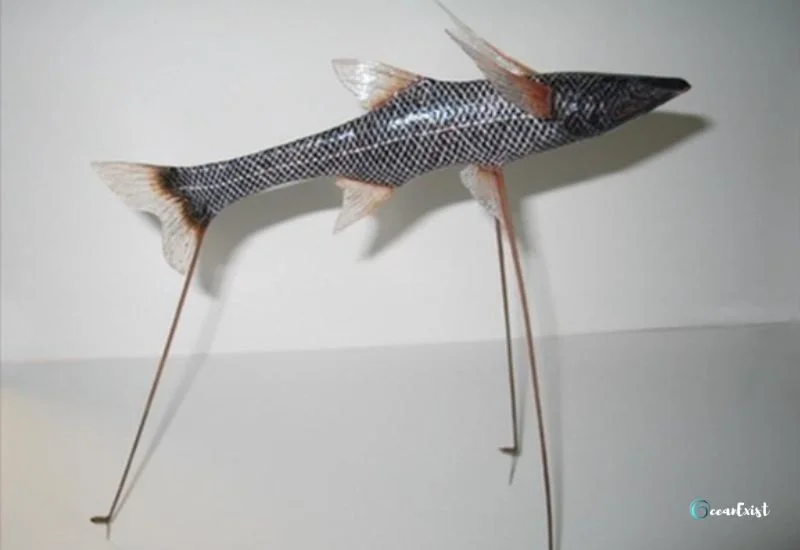
Tripod Spiderfish (Bathypterois grallator) are deep-sea fish. They have long, leg-like extensions from their pectoral and pelvic fins.
These adaptations enable the tripod spiderfish to stand on the seafloor, where they capture prey using their specialized feeding appendages.
- Scientific Name: Bathypterois grallator
- Diet: (Carnivorous) preys on small fish and invertebrates
- Size: 8-12 inches (20-30 cm)
- Origin: Deep-sea habitats worldwide
- Legs: Elongated pectoral and pelvic fins resemble legs for standing on the seafloor
- Available to Hobbyists: Not available
Conclusion
Your search for fish that walk is complete now. These 20 types of fish with legs have made you astounded.
These fish use their fins or limbs to move. Few of the fish can even walk on the land. The most interesting are axolotls.
Unfortunately, Some of the fish are extinct, some are near extinction, and only a few can be available to hobbyists or fish keepers.
It is high time we saved these species. However, we cannot save all, but we can save those we keep in aquariums.
So, here is the guide to maintaining the temperature of the water to ensure the safety and security of the fish.
